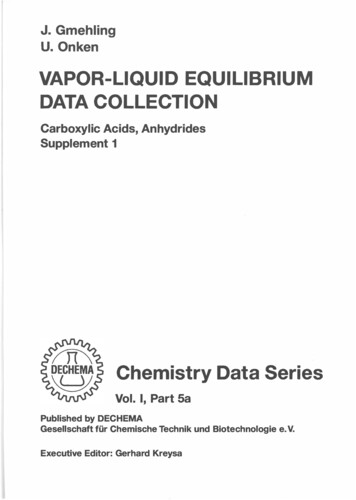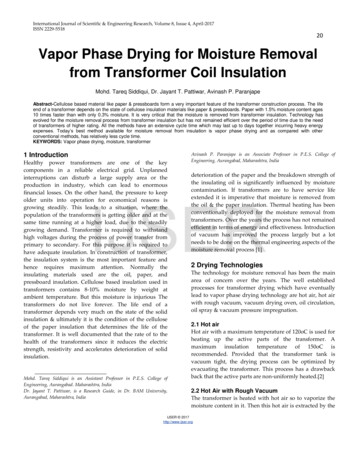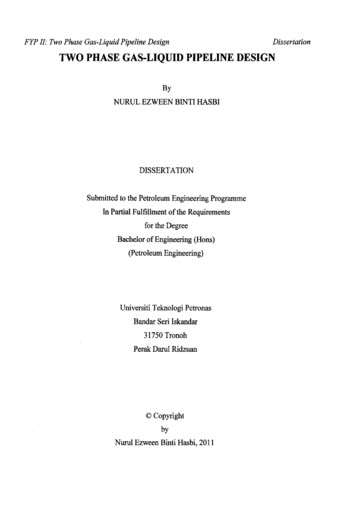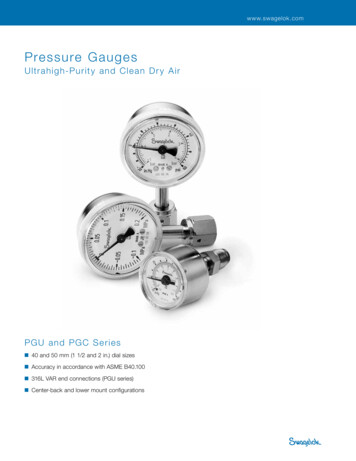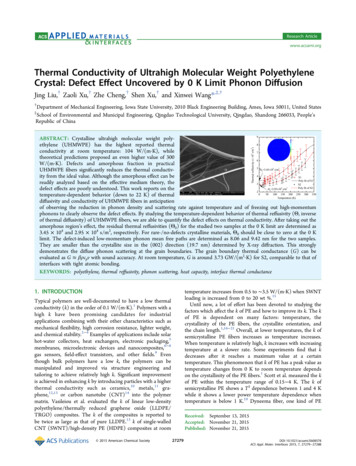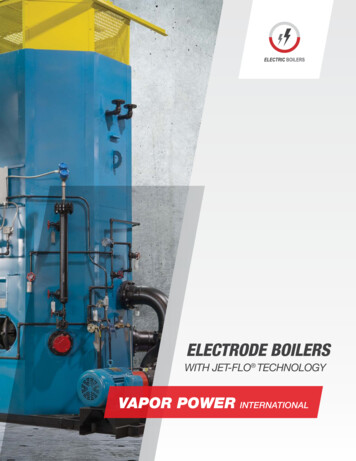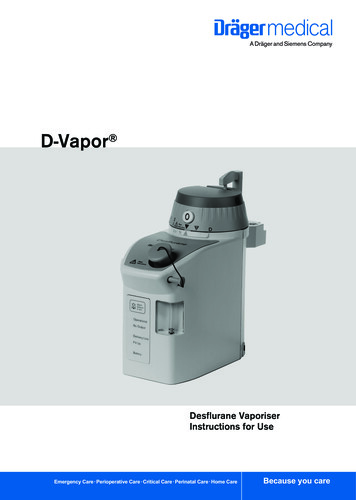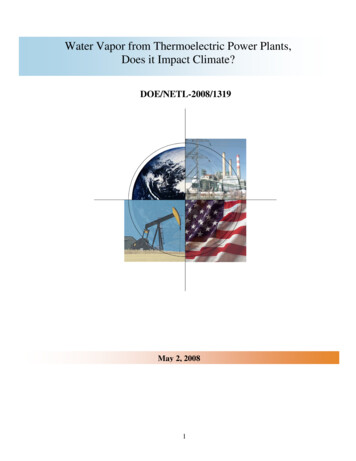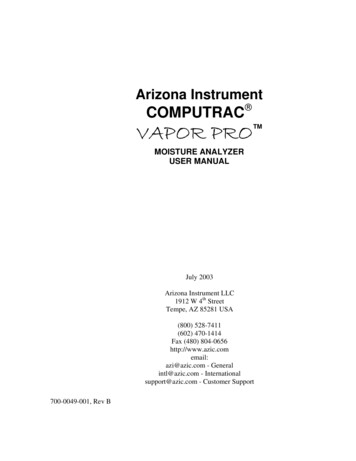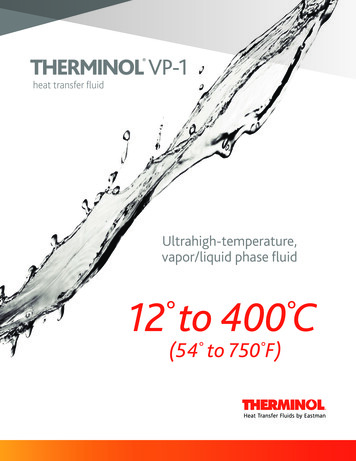
Transcription
THERMINOL VP-1 heat transfer fluidUltrahigh-temperature,vapor/liquid phase fluid12 to 400 C (54 to 750 F)
THERMINOL VP-1 heat transfer fluidMalmorNPhysical and �24p.,emteheat transfer medium up to 400 C (750 F). It is miscible andte.teuspt.inglinkul.biboMTherminol VP-1 is usable as a liquid or as a boiling-condensing Finterchangeable (for top-up or design purposes) with othersimilarly constituted diphenyl oxide/biphenyl fluids.Therminol VP-1 has a low viscosity between its melting point(12 C/54 F) and the temperature at which it vaporizes C(257 C/495 F). In geographic areas where the system may be7420407251245–1exposed to temperatures below this level, all piping that maycontain the fluid in its liquid state should be heat traced.The recommended maximum bulk and film temperatures forEastman Therminol VP-1 heat transfer fluidis specifically designed to meet the demandingrequirements of vapor phase systems. Itcombines exceptional heat stability and lowviscosity for efficient, dependable, uniformperformance in a wide optimum use range.Therminol VP-1 is available globally. Contact yourlocal Eastman Therminol sales representative formore information.Therminol VP-1 are based on industry-standard thermal studies.Operation at or below these temperature maximums can providelong service life under most operating conditions.Actual fluid life is dependent on the total system design andoperation and can vary by heat transfer fluid chemistry. As fluidages under normal operating conditions, a vapor phase fluid willaccumulate low-boiling contaminants such as air, water, anddegradation products. These noncondensables should be ventedfrom the system as necessary to a safe location away frompersonnel and sources of ignition and in compliance withapplicable regulations and laws. Venting noncondensables isalso necessary to avoid aberrations in temperature control. Eachuser or group of users, if arranged in series that operate after thesame control valve, should have at least one vapor accumulator(VA) installed for detecting and venting noncondensables. This isespecially true if close temperature control is needed.Therminol VP-1 is exceptionally heat stable. However, care mustbe taken to avoid overheating, which could lead to deposition ofsolids on the heating surfaces of the vaporizer. Circulation ratesin the heater should be selected to limit skin temperatures toreasonable values, with due consideration to the cost of replacingFor more information about vapor phase system design,damaged fluid and the cost of maintaining an adequate heatflux. This is normally accomplished by the vaporizer or heateroperation, and safety, refer to the Vapor phase designmanufacturer in the course of recommending a particular unitguide or the Therminol VP-1 safety data sheet (SDS).and stipulating its operating parameters.
Typical propertiesaAppearanceClear, water-white liquidCompositionBiphenyl/diphenyl oxide (DPO) eutectic mixtureMaximum bulk temperature400 C (750 F)Maximum film temperature430 C (800 F)Normal boiling point257 C (495 F)Crystallizing point12 C (54 F)Flash point, COC (ASTM D-92)124 C (255 F)Flash point, PMCC (ASTM D-93)110 C (230 F)Autoignition temperature (ASTM E-659)601 C (1114 F)Autoignition temperature (DIN 51794)621 C (1150 F)Coefficient of thermal expansion at 200 C0.000979/ C (0.000544/ F)Heat of vaporization at maximum use temperature206 kJ/kg (88.7 Btu/lb)Total acidity (ASTM D-664) 0.2 mg KOH/gAverage molecular weight166Pseudocritical temperature499 C (930 F)Pseudocritical pressure33.1 bar (480 psia)Pseudocritical density327 kg/m3 (20.4 lb/ft3)Sulfur content (ASTM D-7691) 10 ppmCopper corrosion (ASTM D-130) 1aMoisture content, maximum (ASTM E-203)300 ppmVolume contraction on freezing6.27%Volume expansion on melting6.69%Surface tension in air at 25ºC36.6 dynes/cmDielectric constant @ 23 C (ASTM D-924)3.35T hese data are based on samples tested in the laboratory and are not guaranteed for all samples. Contact us for complete salesspecifications for Therminol VP-1 fluid. Does not constitute an express warranty. See disclaimer on the back page of this bulletin.aTo create your own customized tablewith preferred properties, units of measure,and temperature intervals, visitTherminol.com/resourcesand download the Therminol heat transfer fluid calculator.For technical service, visit the contact page of our website, Therminol.com.
Liquid properties of Therminol VP-1 heat transfer fluid by temperaturea(SI at vitykJ/kgW/(m·K)cP (mPa·s)cSt (mm2/s)Liquid viscositycVaporpressured C 6622.729188.0854.00.07100.1370.2061390Maximum recommended bulk temperature 400 C (750 F). These data are based on samples tested in the laboratory and are not guaranteed for all samples. Contact us for complete salesspecifications for Therminol VP-1 fluid. bThe enthalpy basis is liquid at the crystallizing point 12ºC (53.6ºF). c1 cSt 1 mm2/s and 1 mPa s 1 cP d100 kPa 1 bara
Liquid properties of Therminol VP-1 heat transfer fluid by temperaturea(ENGLISH UNITS)TemperatureLiquid densityLiquidheat capacityHeat vityLiquid viscositycVaporpressured F Clb/gallb/ft3Btu/(lb· F)Btu/lbBtu/lbBtu/(ft·h· F)lb/(ft·h)cSt 20.3230.205218
Vapor properties of Therminol VP-1 heat transfer fluid by temperaturea(SI UNITS)TemperatureVapor densityVaporheat capacityVaporenthalpybVapor thermalconductivityVapor viscosityc C 852.42.171042.00.03250.01400.2683Maximum recommended bulk temperature 400 C (750 F). Vapor properties given for saturated vapor. These data are based on samples tested in the laboratory and are not guaranteed for allsamples. Contact us for complete sales specifications for Therminol VP-1 fluid. bThe enthalpy basis is liquid at the crystallizing point 12ºC (53.6ºF). c1 cSt 1 mm2/s and 1 mPa s 1 cPa
Vapor properties of Therminol VP-1 heat transfer fluid by temperaturea(ENGLISH UNITS)TemperatureVapor densityVaporheat capacityVaporenthalpybVapor thermalconductivityVapor viscosityc F Clb/ftBtu/(lb· F)Btu/lbBtu/(ft·h· 04273.570.526453.40.01910.03430.0142
TLC Total Lifecycle Care programEastman’s TLC Total Lifecycle Care program is designed to support Therminolcustomers throughout their systems’ life cycle. This comprehensive programincludes system design support, start-up assistance, training, sample analysis,flush and refill fluids, and our fluid trade-in program. In North America, call ourhotline at 1-800-433-6997 or contact your local sales or technical representative.In-service heat transfer fluid sample analysis—When Therminol heat transferfluids are used within suggested temperature limits, they may provide years oftrouble-free service. To help users get maximum life, Eastman offers testing ofin-service heat transfer fluids to detect contamination, moisture, thermaldegradation, and other conditions that may impact system performance. Thiscomprehensive analysis includes acid number, kinematic viscosity, insolublesolids, low boilers, high boilers, and moisture content. Additional special analysesare available on request. Sample analysis includes sample collection kits that areeasy to use. Most systems should be sampled annually. Users
Therminol VP-1 has a low viscosity between its melting point (12 C/54 F) and the temperature at which it vaporizes (257 C/495 F). In geographic areas where the system may be exposed to temperatures below this level, all piping that may contain the fluid in its liquid state should be heat traced. The recommended maximum bulk and film temperatures for Therminol VP-1 are based on industry .

